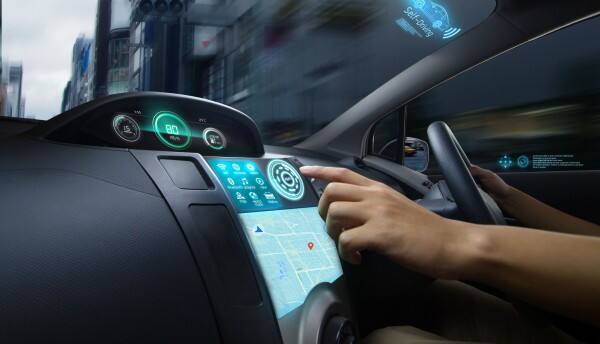Customer Logins
Obtain the data you need to make the most informed decisions by accessing our extensive portfolio of information, analytics, and expertise. Sign in to the product or service center of your choice.
Customer LoginsCan OEMs provide an alternative to Android Auto and Apple CarPlay? GM thinks so.
The automaker has made a bold decision to replace these popular mobile pairing systems, yet its work is cut out to offer equally compelling alternatives that customers will prefer

Source: Getty Images Plus/piyaset
In early April, US automaker General Motors Co. (GM) made an announcement that took the industry by surprise. The original equipment manufacturer plans to phase out popular smartphone pairing systems — Google's Android Auto and Apple's CarPlay — in its future electric vehicle (EV) portfolio and replace them with its own maps, assistance and music through in-built infotainment systems. This is to offer a seamless user experience that will better integrate the connected services in its EVs and take control of the car owners' vehicle data.
Starting in 2024, the Chevrolet Blazer EV will be the first model that will not have either of the currently popular compatibility apps. Instead, the EV will get a new system with access to Google Maps and Google Assistant (a voice command system), at no extra cost for eight years.
This looks like a bet that could offer numerous opportunities and also pose challenges, depending upon how it is viewed. Successful tech companies not only leverage user data generated through their apps to develop products and offer tailor-made services, features and technologies, but to also contribute significantly to their top-line growth. As digital technologies have exploded over the past decade and mobile devices have emerged as the key consumer product, automakers have opened doors to tech players in building products that would boost car sales.
However, OEMs seem to have learned the hard way that data is the new currency, and they might as well use it more effectively to serve their customers better. This makes them reluctant to share data with third-party apps; they would rather take charge of the car users' data to not only develop products and offer seamless user experiences, but also to earn revenues through digital subscription services. This has prompted OEMs to take the complete system under their control and use the data more effectively to open potential revenue streams. To maintain a superior digital experience in the car, GM said it will retain Bluetooth connectivity at a minimum in the Blazer EV for drivers who prefer to stay on the apps with usage directly from their mobile phones. However, to win over customers, OEMs must offer a greater user experience with all the relevant features that are useful to make them likable, user-friendly and most importantly, seamless.
GM would benefit from focusing engineers and investment on one approach to more tightly connecting in-vehicle infotainment and navigation with features such as assisted driving, Edward Kummer, GM's chief digital officer, and Mike Hichme, executive director of Digital Cockpit Experience, told Reuters in an interview on April 1. "We have a lot of new driver assistance features coming that are more tightly coupled with navigation. We don't want to design these features in a way that is dependent on the person having a cellphone."
Partnership with Google
What triggered GM's decision to phase out popular compatibility apps from future EVs is its partnership with Google. In 2019, GM and Google joined hands to develop software that will be completely integrated with its vehicle system. The work has already been underway in designing the navigation and infotainment system for future EVs, such as GM's in-house Super Cruise driver assistance, and this is the concurrence of the OEM's strategy to accelerate its EV platforms for digital subscription services. GM projects annual software and services revenue opportunities between $20 billion and $25 billion from its projected 30 million connected vehicles by the end of 2030.
It is a rational decision for GM not to offer Android Auto and Apple CarPlay. However, the popularity of these apps, car users' preferences and the comfort and convenience they offer make them essential for OEMs. Can conventional automakers triumph over tech companies in providing the same user experience with their own in-built system? GM certainly believes so, and the company is working in exactly that direction. However, it is easier said than done, simply because Apple and Android apps have been around for a while, promising a greater user experience with the OEM's current vehicle platform. These apps have become a huge part of car users' daily needs with useful tools such as navigation, music, apps and seamless phone pairing.
While GM's decision to not offer Android Auto and Apple CarPlay starting with the 2024 Chevy Blazer appears rather swift, the OEM has assured existing customers that both the apps will continue to be offered on all internal combustion vehicles. Also, given the shift toward sustainable transportation, GM plans to completely stop producing combustion engine vehicles by 2035.
Similarly, the current owners of Cadillac, Chevy, GMC and Buick models will continue to get access to Android Auto or Apple CarPlay — the OEM even partnered exclusively with Google for its software. GM also noted that the upcoming Silverado Pickup will be compatible with Android Auto and Apple CarPlay.
OEMs' preference
Looking at the new automakers in the industry, it appears GM's decision is quite a trend, and the logical way to move ahead in the connected, electric and software-driven world of vehicles. OEMs such as Tesla, Rivian and others do not offer either Android Auto or Apple CarPlay in their cars; both companies have developed a proprietary system. This completely in-house standard system in their cars gives them full control rather than letting that control go to a third party. The OEMs can control the system, user experience and data, which they can leverage to then offer subscription services, tailor-made features and technologies. German brand Volkswagen, through its software arm CARIAD, is working on developing its own software and infotainment system independent of a third party.

The broader industry seems to take a different approach, as established brands are not changing the status quo. Automakers such as Stellantis, BMW, Hyundai, Ford and more, are fine with the third-party apps and do not have any plans to do away with Android Auto and Apple CarPlay for now.
Customers' choice
While OEMs are trying everything, they can ultimately make their car buyers' decisions easier by providing what is best for them. However, customers seem to be quite comfortable with what they already have, for example, Apple says that over 80% of new car buyers look for the CarPlay feature before making their decision. Apple's future updates that include seat control and climate control will make it an even more compelling choice — which makes GM's decision even more puzzling. It is noted that car buyers across segments desire Android Auto and Apple CarPlay in their cars.
In 2021, GM also announced Ultifi, its end-to-end software platform designed to offer a superior digital experience to customers. The new software will enable the frequent and seamless delivery of software-defined features, apps and services to customers over the air. Ultifi works on GM's advanced electrical architecture — the Vehicle Intelligence Platform (VIP). VIP-enabled vehicles provide over-the-air capability, plenty of data bandwidth, robust cybersecurity and lightning-fast processing power. GM believes the Ultifi platform will then enable accelerated development and deployment of software and applications over the air to millions of customers, without affecting basic hardware controls.
Conclusion
GM is venturing into the domain of highly competitive tech companies with a completely new approach. However, if the automaker is successful in offering what the customer wants, it would be a huge win. It would open a sea of opportunities to leverage vital data from its connected vehicles to offer value to features and race ahead of its rivals.
Undoubtedly, Tesla and Rivian behave more as tech companies and in general, do not tend to follow the unwritten automotive industry rules. What remains to be seen is if GM is really on the same playing field and able to go against what customers still seem to want in an infotainment system — smartphone projection capability. Tesla and Rivian have certainly proven that they can do without Android Auto or Apple CarPlay, but for GM, getting this wrong might mean it could backfire, since GM customers are already used to having access to these technologies.
This article was published by S&P Global Mobility and not by S&P Global Ratings, which is a separately managed division of S&P Global.

